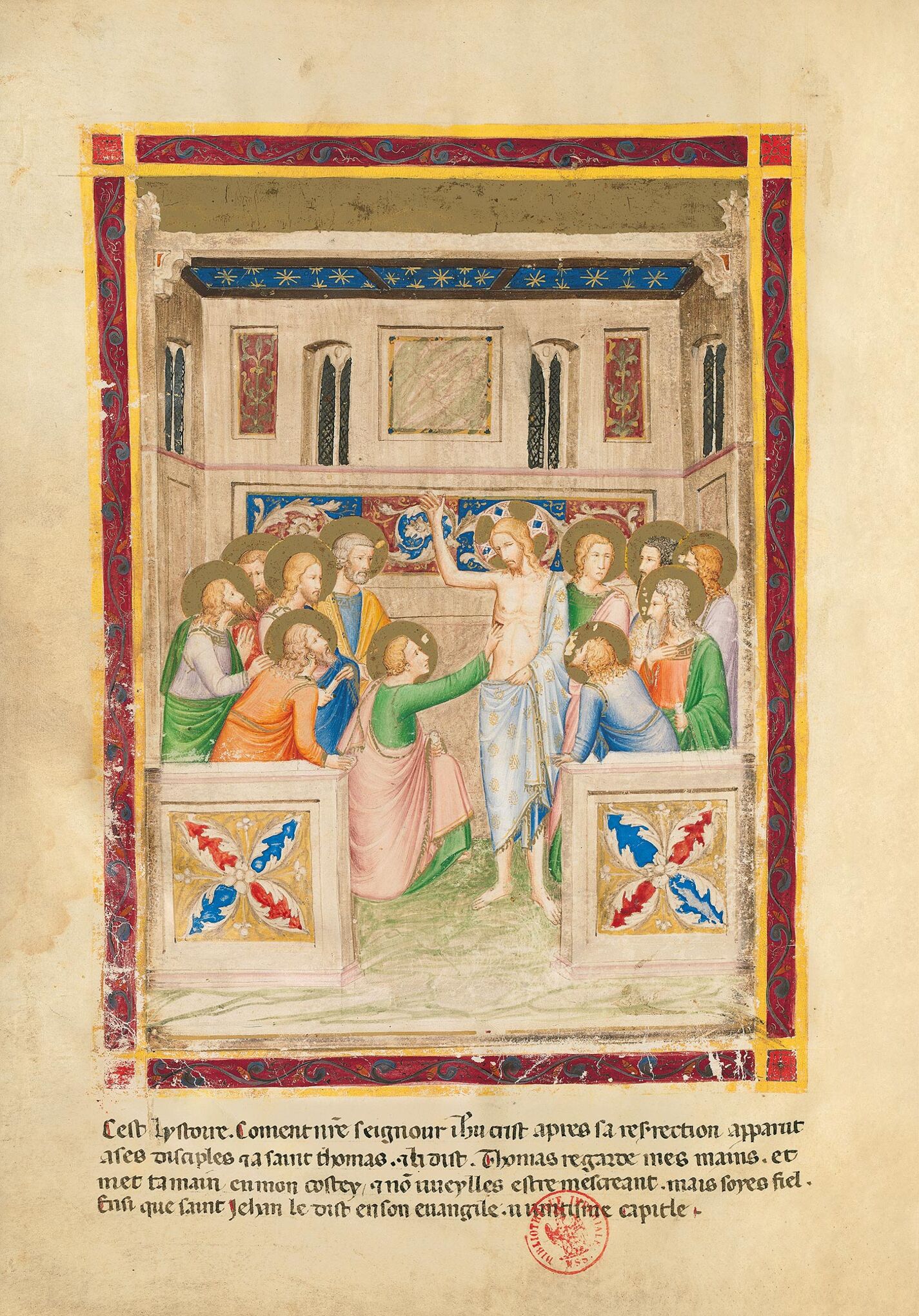“This is the story: How Our Lord Jesus Christ after his Resurrection appeared to his disciples and to Saint Thomas and said to him: Thomas look at my hands and put your hand in my side and disbelieve you not but have faith. Thus says Saint John in his Gospel, in the twentieth chapter.”
After appearing to Mary Magdalene, the Lord visits his disciples in the house where they usually met. Painter B resorts to the box structure open at the front as the setting for the episode of St Thomas’s disbelief but unlike illuminator A, painter B does not overemphasise the diagonal lines of the vanishing points; the unified perspective provides a modern, illusionist view of the space depicted.
The indoor scene is portrayed like a splendid Gothic chapel decorated with Giottoesque acanthus motifs (cf. the Peruzzi chapel in the Santa Croce church, Florence, c. 1310-1315). The ceiling is simply strewn with golden stars but the coloured marble portrayed, particularly on the floor, reveals a masterful pictorial savoir-faire. The eleven apostles (Judas having not yet been replaced) surround the risen Christ who has suddenly appeared amongst them despite “the doors being shut” (John 20: 26). He says to Thomas, “bring hither the hand and put it into my side. And be not faithless, but believing” (John 20: 27). The disciples become very restless and they lean towards Jesus or look at each other stunned. The Messiah has stripped to the waist to reveal his right side and holds his arm aloft whilst Thomas kneels at his feet and puts two fingers into the gaping wound caused by the centurion’s spear during the Crucifixion. Christ’s cloak is shaded with bluish highlights and the gowns of the apostles around him form a circle of bright, acid complementary hues. Their faces are all different and form a gallery of sensitive portraits. The master’s hand can be seen in the very graphic portrayal of the hair, the generous yet flowing volumes of the bodies moulded by folds of fabric and chromatic nuances which simulate light. The flesh tints are delicately rendered and Christ’s slender body with its striking anatomic realism radiates a pearly light that identifies the key figure of this composition.
Yves Christe
University of Geneva
Marianne Besseyre
Illuminated Manuscripts Research Center, Bibliothèque nationale de France
Fragment of the Bible moralisée of Naples commentary volume

“This is the story: How Our Lord Jesus Christ after his Resurrection appeared to his disciples and to Saint Thomas and said to him: Thomas look at my hands and put your hand in my side and disbelieve you not but have faith. Thus says Saint John in his Gospel, in the twentieth chapter.”
After appearing to Mary Magdalene, the Lord visits his disciples in the house where they usually met. Painter B resorts to the box structure open at the front as the setting for the episode of St Thomas’s disbelief but unlike illuminator A, painter B does not overemphasise the diagonal lines of the vanishing points; the unified perspective provides a modern, illusionist view of the space depicted.
The indoor scene is portrayed like a splendid Gothic chapel decorated with Giottoesque acanthus motifs (cf. the Peruzzi chapel in the Santa Croce church, Florence, c. 1310-1315). The ceiling is simply strewn with golden stars but the coloured marble portrayed, particularly on the floor, reveals a masterful pictorial savoir-faire. The eleven apostles (Judas having not yet been replaced) surround the risen Christ who has suddenly appeared amongst them despite “the doors being shut” (John 20: 26). He says to Thomas, “bring hither the hand and put it into my side. And be not faithless, but believing” (John 20: 27). The disciples become very restless and they lean towards Jesus or look at each other stunned. The Messiah has stripped to the waist to reveal his right side and holds his arm aloft whilst Thomas kneels at his feet and puts two fingers into the gaping wound caused by the centurion’s spear during the Crucifixion. Christ’s cloak is shaded with bluish highlights and the gowns of the apostles around him form a circle of bright, acid complementary hues. Their faces are all different and form a gallery of sensitive portraits. The master’s hand can be seen in the very graphic portrayal of the hair, the generous yet flowing volumes of the bodies moulded by folds of fabric and chromatic nuances which simulate light. The flesh tints are delicately rendered and Christ’s slender body with its striking anatomic realism radiates a pearly light that identifies the key figure of this composition.
Yves Christe
University of Geneva
Marianne Besseyre
Illuminated Manuscripts Research Center, Bibliothèque nationale de France
Fragment of the Bible moralisée of Naples commentary volume